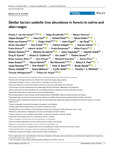Mostrar o rexistro simple do ítem
Similar factors underlie tree abundance in forests in native and alien ranges
| dc.contributor.author | van der Sande, Masha T. | |
| dc.contributor.author | Fagúndez, Jaime | |
| dc.date.accessioned | 2020-01-28T09:22:22Z | |
| dc.date.available | 2020-01-28T09:22:22Z | |
| dc.date.issued | 2019-12-01 | |
| dc.identifier.citation | van der Sande, MT, Bruelheide, H, Dawson, W, et al. Similar factors underlie tree abundance in forests in native and alien ranges. Global Ecol Biogeogr. 2020; 29: 281– 294. https://doi.org/10.1111/geb.13027 | es_ES |
| dc.identifier.issn | 1466-8238 | |
| dc.identifier.uri | http://hdl.handle.net/2183/24763 | |
| dc.description.abstract | [Abstract] Aim: Alien plant species can cause severe ecological and economic problems, and therefore attract a lot of research interest in biogeography and related fields. To identify potential future invasive species, we need to better understand the mechanisms underlying the abundances of invasive tree species in their new ranges, and whether these mechanisms differ between their native and alien ranges. Here, we test two hypotheses: that greater relative abundance is promoted by (a) functional difference from locally co‐occurring trees, and (b) higher values than locally co‐occurring trees for traits linked to competitive ability. Location: Global. Time period: Recent. Major taxa studied: Trees. Methods: We combined three global plant databases: sPlot vegetation‐plot database, TRY plant trait database and Global Naturalized Alien Flora (GloNAF) database. We used a hierarchical Bayesian linear regression model to assess the factors associated with variation in local abundance, and how these relationships vary between native and alien ranges and depend on species’ traits. Results: In both ranges, species reach highest abundance if they are functionally similar to co‐occurring species, yet are taller and have higher seed mass and wood density than co‐occurring species. Main conclusions: Our results suggest that light limitation leads to strong environmental and biotic filtering, and that it is advantageous to be taller and have denser wood. The striking similarities in abundance between native and alien ranges imply that information from tree species’ native ranges can be used to predict in which habitats introduced species may become dominant. | es_ES |
| dc.description.sponsorship | Netherlands Organisation for Scientific Research; 019.171LW.023 | es_ES |
| dc.description.sponsorship | German Research Foundation; 264740629 | es_ES |
| dc.description.sponsorship | Chile. Fondo Nacional de Desarrollo Científico y Tecnológico; 11150835 | es_ES |
| dc.description.sponsorship | Chile. Comisión Nacional de Investigación Científica y Tecnológica; 82130046 | es_ES |
| dc.description.sponsorship | European Research Council Synergy; ERC‐SyG‐2013‐610028 IMBALANCE‐P | es_ES |
| dc.description.sponsorship | Austrian Science Foundation; I2086‐B16 | es_ES |
| dc.description.sponsorship | Czech Science Foundation; 14‐15414S | es_ES |
| dc.description.sponsorship | Czech Academy of Sciences; RVO 67985939 | es_ES |
| dc.description.sponsorship | Czech Science Foundation; 19‐28807X | es_ES |
| dc.description.sponsorship | Slovak Republic; Ministry of Education, Science, Research and Sport; VEGA 0119/19 | es_ES |
| dc.language.iso | eng | es_ES |
| dc.publisher | Wiley | es_ES |
| dc.relation | info:eu-repo/grantAgreement/EC/FP7/274798 | es_ES |
| dc.relation.uri | https://doi.org/10.1111/geb.13027 | es_ES |
| dc.rights | Atribución 3.0 España | es_ES |
| dc.rights.uri | http://creativecommons.org/licenses/by/3.0/es/ | * |
| dc.subject | Abundance | es_ES |
| dc.subject | Dissimilarity | es_ES |
| dc.subject | Forest | es_ES |
| dc.subject | Functional traits | es_ES |
| dc.subject | Global | es_ES |
| dc.subject | Plant invasion | es_ES |
| dc.subject | Trees | es_ES |
| dc.title | Similar factors underlie tree abundance in forests in native and alien ranges | es_ES |
| dc.type | info:eu-repo/semantics/article | es_ES |
| dc.rights.access | info:eu-repo/semantics/openAccess | es_ES |
| UDC.journalTitle | Global Ecology and Biogeography | es_ES |
| UDC.volume | 29 | es_ES |
| UDC.issue | 2 | es_ES |
| UDC.startPage | 281 | es_ES |
| UDC.endPage | 294 | es_ES |






